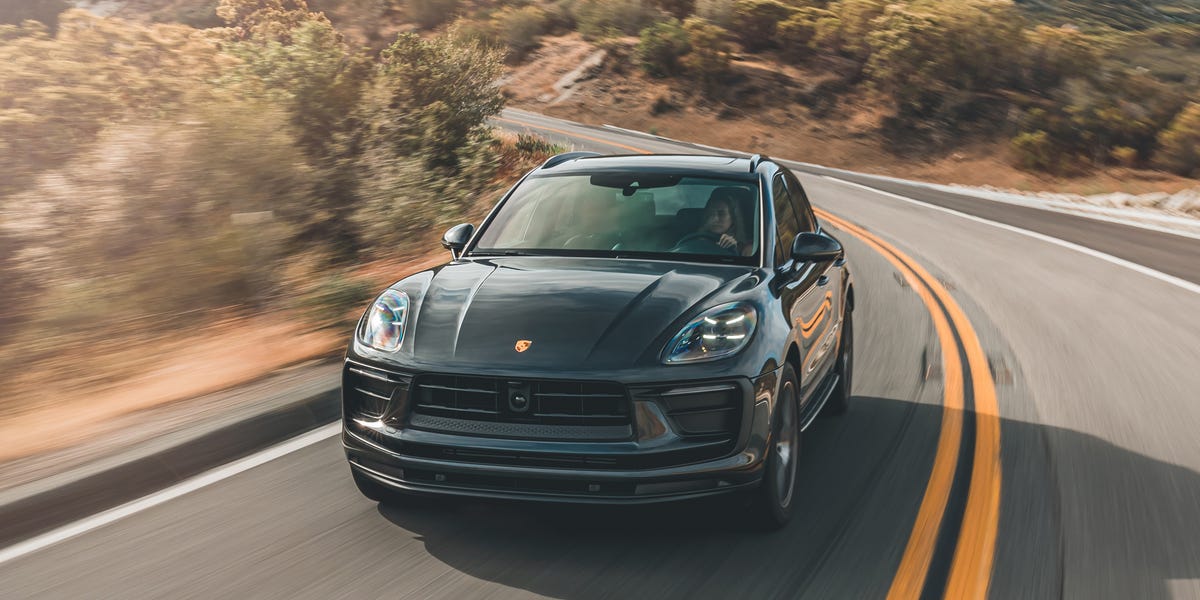2022 Porsche Macan Tested: A Solid Foundation

Who put a Volkswagen engine in my Porsche? It’s a question as old as the brand itself, so it shouldn’t surprise anyone that Porsche equips its base Macan crossover with a VW/Audi-sourced turbocharged 2.0-liter inline-four. The brand has been putting that engine in the Macan for years, it’s just that this is the first time we’ve been able to test one. Sure, it’d be a potentially more Porsche experience if the Macan borrowed the turbo 2.0-liter flat-four from a 718 Boxster or Cayman, but we know that playing these sorts of “what if” games always end with Bugatti’s quad-turbo 8.0-liter W-16.
We’ve long had some “what ifs” about the base Macan, as Porsche has never loaned us one. It’s the bestselling Macan model, accounting for around 60 percent of sales, and its engine is a ripper in things like the Volkswagen GTI and the Audi A4. In the Macan, the 261-hp turbo four finds itself pushing against 4199 pounds of Porsche. But equipping the Macan with the Sport Chrono option ($1220) adds a wart-like stopwatch to the top of the dashboard and some critical launch-control software. Engaging the system revs the Macan’s four to 5200 rpm before sending all 261 horses charging into the seven-speed dual-clutch automatic. Porsche doesn’t dumb down the launch control for its SUVs, and it works as well here as it does in its sports cars. Thanks to the aggressive take-off procedure, 60 mph falls in a respectable 5.0 seconds flat. Take out the hard launch and floor it from a 5-mph roll, and the 60-mph trip stretches to 5.9 seconds.
HIGHS: Smarty-pants automatic transmission with launch control, sufficient poise to loom large in sports cars’ mirrors.
If this is the only Macan you’ve driven, this engine will rate somewhere between lovely and more than adequate. But we’ve driven other Macans, and next to the rich timbre and backrest-imprinting thrust of the rest of the lineup’s turbocharged V-6s, the four has to work harder and will occasionally sound like it’s gathering a loogie. The sound does remain in the background, though, as the engine only musters 73 decibels of noise at full throttle. The dual-clutch automatic works well to give you a Porsche experience, quickly downshifting and holding lower gears to help make the most out of the engine. But even it seems to recognize the futility of sending this 2.0-liter mill to its 6800-rpm redline. Unlike the engines that Porsche builds, this one doesn’t get sweeter the closer you are to the redline. Fuel economy is slightly better than the turbocharged V-6s in the rest of the Macan lineup. The four-cylinder earns 21 mpg combined in EPA testing versus the 19 combined for the 375-hp Macan S and 434-hp Macan GTS models.
Aside from the sound of the engine, there aren’t many clues inside this Macan to indicate you’re in a basic version. At 70 mph the cabin only registers a luxury-car-quiet 66 decibels. Porsche’s touchscreen infotainment system does require some familiarization, as the menu structure will undoubtedly confuse new users, but phone mirroring through Apple CarPlay (Android Auto isn’t on the menu) ameliorated most of our complaints. Rear-seat space remains on the tight side of the segment, but headroom is excellent, and the rear-seat shape and cushioning provide long-distance support. On the base version’s 19-inch wheels the ride quality is free of jitters and whacks, provided you don’t set the optional adaptive dampers to Sport mode.
LOWS: Occasional moans from the engine room, relatively soft on power.
Thanks to the selection of chassis upgrades on our test car, this base Macan untangled twisty tarmac with an enthusiasm that reminds us of Porsche’s own sports cars. If that’s important to you be sure to specify the adaptive dampers ($1360), Torque Vectoring Plus ($1500), and summer tires for the standard 19-inch wheels—at least that one’s a freebie—and this lightest version of the Macan, with its 0.89 g of grip, will run with most traffic you’ll likely find on a canyon road. If you read our Macan GTS review, you’ll note that the GTS pulled 0.98 g on the skidpad. But credit its wider tires and track-focused Pirelli P Zero Corsas for that impressive achievement. Most of the suspension upgrades on our test car can now be had on the new Macan T, which will make finding the right mix of handling options easier. Driven aggressively and with a badge delete, no one will ever suspect that there’s anything but a Porsche engine under the hood.
A car-lover’s community for ultimate access & unrivaled experiences. JOIN NOW
This content is created and maintained by a third party, and imported onto this page to help users provide their email addresses. You may be able to find more information about this and similar content at piano.io



